
Mastering Enterprise JavaBeans™ and the Java 2 Platform, Enterprise Edition - Roman E
..pdf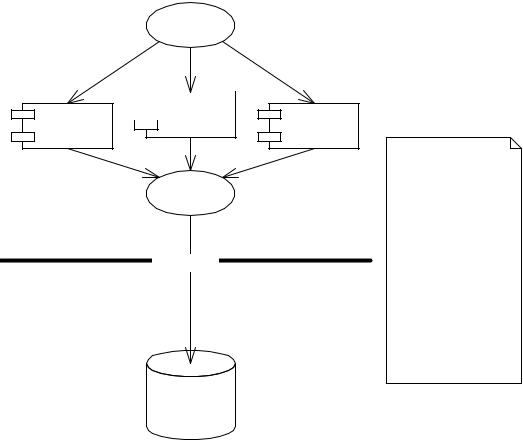
Server-side Component Architectures |
|
15 |
Presentation
Logic
|
Pricing |
|
|
Billing |
|
|
|
||
|
|
|
||
|
|
|||
|
|
|
Component |
|
|
||||
|
|
|
Component
Database Driver
Tier Boundary
Database
Presentation / Business Logic Layer
Fulfillment
Component
- Since Database Driver is installed on client, a change of Database Drivers means redeploying many machines
- Since Business Logic Components are installed on client, a change of business logic means recompiling and redeploying many client machines
- Client installs are cumbersome and bulky
- No database connection pooling between disparate clients
Data Layer
Figure 1.6 Combining presentation with business logic in a two-tier architecture.
In a two-tier architecture, the client application typically communicates with the data layer through a database bridge API such as Open Database Connectivity (ODBC) or Java Database Connectivity (JDBC). This decouples the client from the particular database being used. So that each vendor’s proprietary database will conform to the database bridge, each database vendor must supply a database driver that is called from the database bridge API, such as an ODBC driver or JDBC driver.
Two-tier architectures have the following characteristics:
Deployment costs are high. Database drivers must be installed and configured on each of the client tiers, which may mean hundreds or thousands of machines.
Database driver switching costs are high. Switching one database driver with another now requires a reinstallation of every client machine’s database
Go back to the first page for a quick link to buy this book online!
16 |
|
M A S T E R I N G E N T E R P R I S E J A V A B E A N S |
drivers. This is very costly from a maintenance perspective because the client tier could reside on the desktops of hundreds or thousands of client machines. For example, the size and mobility of a sales force could make uniform upgrades on all the individual laptops virtually impossible.
Database schema switching costs are high. The fat clients directly access the database via JDBC, SQL/J, or ODBC. This means that the clients are dealing directly with the underlying database schema. If you ever decide to migrate the schema to handle new business processes, you need to redeploy each client.
Database type switching costs are high. The fat clients are bound to a database API, such as a relational database API or an object database API. If you ever decide to switch between database types (such as switching from a relational database to an object database), you must not only redeploy each client, but you must drastically change the client code to suit the new database type.
Business logic migration costs are high. Changing the business logic layer involves recompiling and redeploying the client tier.
Database connection costs are high. Every database client needs to establish its own database connection. These connections are limited in number and costly to establish. When clients are not using the database, the connection is often still held and cannot be used by others.
Network performance suffers. Each time your business logic performs a database operation, you need to make a number of roundtrips across the physical boundary separating the business logic layer and the data layer. If this barrier is a network boundary, it could severely hamper the total time a database operation takes—and it could clog the network, reducing the amount of bandwidth other users have.
Pushing Some of the Business Logic Layer into the Data Layer
More recently, deployments have begun to combine parts of the business logic layer with the data layer into a separate tier. This is illustrated in Figure 1.7. If you think of the first tier as a “client” and the second tier as a “server,” this architecture effectively makes the client “thin” and the server “fat.”
To actualize this scenario, you push some of your business logic (usually your persistence-related data logic) within the database. Databases allow you to execute logic within the database’s context by writing a suite of modules known as stored procedures. By pushing select parts of your logic into stored procedures, you gain a number of scalability and performance enhancements. For one, because you are pushing some logic inside of the database, the network round trip from the logic to the database is minimized. Rather than performing n database queries, you can call one procedure kept inside the database, which performs n queries for you. This saves you many round trips, increasing the speed
Go back to the first page for a quick link to buy this book online!
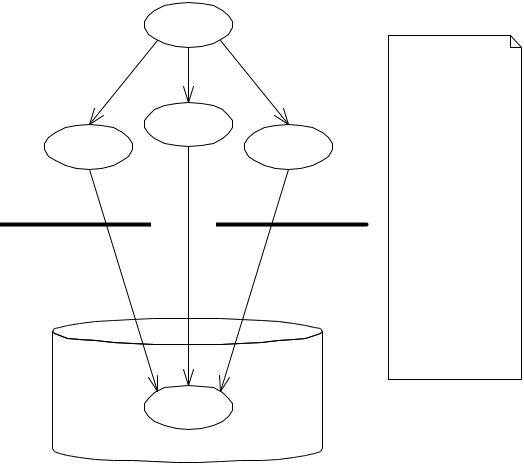
Server-side Component Architectures |
|
17 |
Presentation
Logic
Presentation Layer
Billing Logic
Fulfillment
Pricing Logic
Logic
Tier Boundary
Business Logic / Data Layer
-Our Data Access Logic is now running in the Database as stored procedures
-Business Logic Components may not be portable components if a proprietary stored procedure language is
used.
- Vendors of Business Logic cannot resell their code to be used in a different database without significant code changes.
- Network roundtrip latency is reduced for data access.
- Cost of an IT Department changing to a different database is very expensive.
Stored
Procedures
Database
Figure 1.7 Pushing data access logic into the second tier in a two-tier architecture.
of database operations. It also reduces total network traffic, enabling other clients to perform network operations more speedily.
Thus, having database-specific logic within the database does enhance performance and increases the overall deployment scalability. Most of the other problems with two-tiered approaches listed previously, however, still apply. And while the development of stored procedures is an important step forward, they do not solve every problem. In fact, they add some problems of their own. For example, stored procedure languages are often proprietary, which ties clients to a particular database. The whole point of having a database bridge such as ODBC or JDBC, allowing any database to plug in, was defeated. Now it becomes even harder to plug in a database of a different genre, such as an object database. It
Go back to the first page for a quick link to buy this book online!
18 |
|
M A S T E R I N G E N T E R P R I S E J A V A B E A N S |
should be noted, however, that Java is being used more and more as a stored procedure language, which enhances the portability of stored procedures.
N-Tier Architectures
An N-tier architecture adds one or more tiers to the two-tier model. In N-tier deployments, your presentation layer, business logic layer, and data layer are separated into respective physical tiers. With four or more tiers, you decompose each of these layers even further to allow various parts of your system to scale independently.
A concrete example of an N-tier architecture is a three-tiered Web-based deployment, as illustrated in Figure 1.8. A three-tiered Web-based deployment is typically broken down as follows:
Your presentation tier runs within the address space of one or more Web servers. It consists of Java servlets, scripts to customize look-and-feel (such as Active Server Pages, Java Server Pages, etc.), and workflow logic that ties things together.
Your business logic tier runs within the address space of one or more application servers. Application servers are necessary to provide a suitable containment environment for the business logic components to run in. The application server also manages these components efficiently and provides a number of services to the components. For example, the application server provides a database access layer for the business components, allowing the business components to persist data to and load data from the data tier. The application server is also responsible for making the business components available to be used, instantiating them as necessary.
Your data tier consists of one or more databases and may contain data-related logic in the form of stored procedures.
Note that a single-company Web deployment is only one example of a viable N-tier deployment. Another example is a banking system that has many tiers, with each tier representing a department of a bank. Another example is a control system that does not have a graphical user interface, yet also requires several tiers. Yet another example is a distributed deployment that spans company boundaries, where several companies work together to provide enhanced value (such as an online purchasing store that involves UPS for shipping logic and VISA for credit card logic).
N-tier architectures have the following characteristics:
Deployment costs are low. Database drivers are installed and configured on the server-side, rather than on client machines. It is much cheaper to deploy and configure software in a controlled server-side environment than to deploy
Go back to the first page for a quick link to buy this book online!
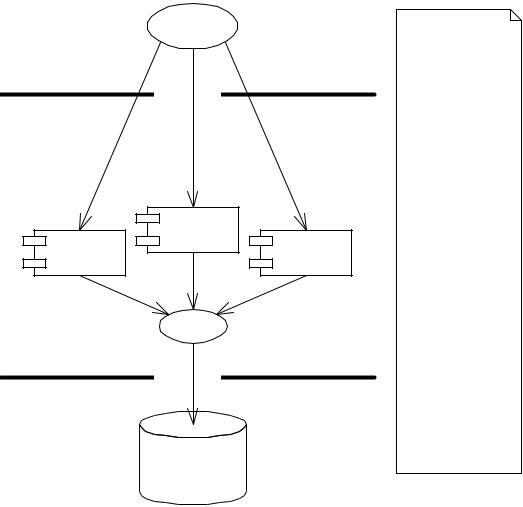
Server-side Component Architectures |
|
19 |
Presentation |
Presentation Layer |
|
Logic |
||
|
Tier Boundary
Business Logic Layer
(Application Server)
|
Billing |
|
Component |
Pricing |
Fulfillment |
Component |
Component |
Database
Driver
Tier Boundary
Data Layer
-Business Logic Components are true components, since they are written in a nonproprietary language.
-Vendors of Business Logic can easily resell their code. It will run in any database that has a
corresponding driver.
- Application Server vendors must agree on a unified set of services and service APIs which they offer Business Components, else the components are nonportable.
-Client deployments are thin and simple.
-Maintenance of three physical tiers is expensive.
-Automatic database connection pooling.
-Cost of an IT Department changing to a different database is cheap.
Database
Figure 1.8 An N-tier architecture.
software on (for example) thousands of salesmen’s laptops, or on thousands of end user terminals.
Database switching costs are low. Clients no longer access the database directly, but rather go through the middle tier for data access. This enables you to migrate database schemas, change to different database drivers, or even change your persistent storage type without re-deploying clients.
Business logic migration costs are low. Changing the business logic layer may not necessitate recompiling and redeploying the client tier.
Go back to the first page for a quick link to buy this book online!
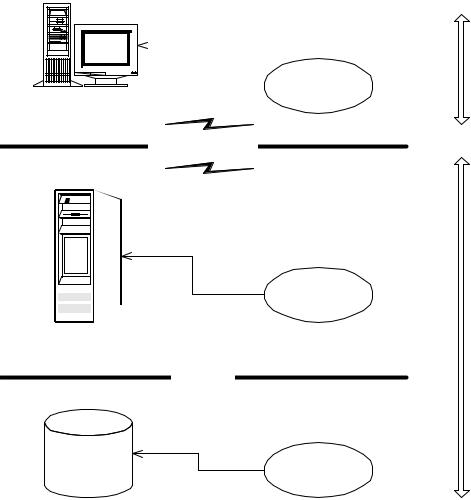
20 |
|
M A S T E R I N G E N T E R P R I S E J A V A B E A N S |
You can secure parts of your deployment with firewalls. Many businesses are sensitive about protecting their data, yet they do not want to hamper a deployed application. For example, in a Web-based deployment, businesses may not want to expose their business layer directly to outside users. Yet the deployment must expose the presentation layer to outside users so that they can hit the Web site. A solution is to place a firewall in between the presentation and business logic tiers, as shown in Figure 1.9
Resources can be efficiently pooled and re-used. With an N-tier architecture, connections to external resources can be managed very efficiently. Resource pooling exploits the fact that clients are often doing other things
 Presentation Layer
Presentation Layer
Web Server
Firewall + Tier Boundary
Business Logic
Layer
Application Server with Component Container
Tier Boundary
Data Layer
Database
Figure 1.9 Security reasons often necessitate three-tier divisions.
Insecure
Zone
Secure
Zone
Go back to the first page for a quick link to buy this book online!
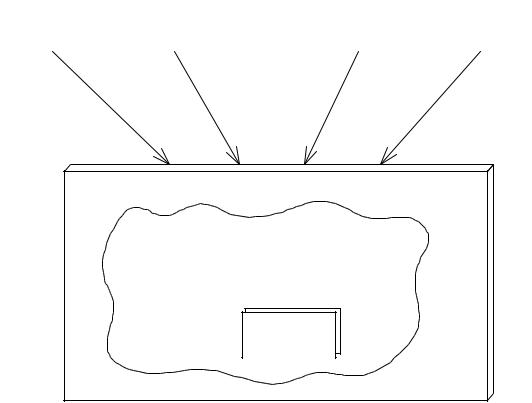
Server-side Component Architectures |
|
21 |
besides using resources, such as rendering a graphical user interface. Rather than your business components acquiring and releasing connections to resources (such as databases), the resources can be pooled and re-used for different client requests. The resulting set of database connections required is often far less than the total number of components in a deployed system. Because database connections are very expensive, this paradigm increases the overall scalability of the deployment. Furthermore, connections to resources do not need to be re-established continuously, improving application performance. Resource pooling can be applied to other resources as well, such as socket connections and threads. In fact, with an N-tier architecture, the business components themselves can be pooled and reused by multiple clients. Pooling of components means you don’t need a dedicated component for each client, as is true with two-tier thick clients. The pooling of resources is illustrated in Figure 1.10.
Each tier can vary independently. For example, you can add database images while minimizing changes and recompilations of the other tiers.
Client |
|
Client |
... |
Client |
|
Client |
|
|
|
||||
|
|
|
|
|
|
|
Application Server
Pools
|
|
|
|
|
|
|
|
|
|
|
|
|
Business |
|
|
|
|
Database |
|
|
|
|
|
|
|||||
|
|
|
Components |
|
|
|
|
Connections |
|
|
|
|
|
|
|
|
|
|
|
Sockets
Figure 1.10 Pooling of resources in an N-tier deployment.
Go back to the first page for a quick link to buy this book online!
22 |
|
M A S T E R I N G E N T E R P R I S E J A V A B E A N S |
Performance slowdown is localized. If one tier is overloaded, the other tiers can still function properly. In a Web deployment, users may able to view your front page even though the application server is overburdened.
Errors are localized. If a critical error occurs, it is localized to a single tier. The other tiers can still function properly, gracefully dealing with the situation. For instance, if your application server crashes, your Web server could report a “site down” page to client browsers.
Communication performance suffers. Since the tiers are physically separate, they must communicate across process boundaries, across machine boundaries, or across enterprise domain boundaries. This results in high communications overhead. Only by designing your distributed object application properly can you have an efficient deployment. Unfortunately, this often necessitates being very aware of tier boundaries and reduces the location transparency of your application code.
Maintenance costs are high. You are deploying in three or more physically separate tiers. Software installation costs, software upgrade costs, redeployment costs, and administration costs increase significantly.
Making Multi-tier a Reality
The benefits of multi-tier deployments do not come for free. Someone, at some point in time, needs to write the code that will:
■■Broker method requests
■■Perform resource pooling
■■Handle the lifecycle of your components
■■Handle the logic to load-balance communications between each tier
■■Deal with the ramifications of two or more clients concurrently accessing the same component
■■Reroute client requests to other machines in case of failure
■■Provide a secure environment so that unauthorized clients cannot sabotage the system state
■■Provide monitoring software that might page a system administrator in case of catastrophic problems
■■Authorize users to perform secure operations
■■And much, much, much more.
Each of these issues is a separate service that needs to be addressed for serious server-side computing. And each of these services requires a lot of thought and a lot of network middleware plumbing to resolve. Often times, companies
Go back to the first page for a quick link to buy this book online!

Server-side Component Architectures |
|
23 |
build in-house proprietary frameworks that give some of these services. Those companies are setting themselves up for failure, because high-end application servers are hideously complicated to build and maintain, require expert-level knowledge of middleware, gain support of industry-standard tools, and are completely orthogonal to most companies’ core business. Why not build instead of buy?
The application server was born to let you buy these middleware services, rather than build them yourself. Application servers provide a runtime environment for server-side components. They provide component developers with common middleware services, such as resource pooling, networking, and more. Application servers allow you to focus on your application, and not worry about the middleware you need for a robust server-side deployment.
Server-Side Component Architecture Solutions
It has been a number of years now since the idea of multi-tier server-side deployments surfaced. Since then, multitudes of application servers have begun to appear on the market. These application servers provide a usable runtime environment in which components can execute and provide the needed middleware services (such as resource pooling and security) for reliability and scalability. But unfortunately, up until now there has not been a definition of what a middletier component really is. Because of this, each application server has been providing component services in a non-uniform, proprietary way. This means that once you bet on an application server, your code is locked into that vendor’s solution. This greatly reduces portability and is an especially tough pill to swallow in the Java world, which promotes portability. It also hampers the commerce of components because a customer cannot combine a component written to one application server with another component written to a different application server.
From this, the need for a standard architecture for server-side components has arisen. This architecture needs to craft a well-formed interface between the application server, which contains the components, and the components themselves. These interfaces allow the components to be managed in a portable way, rather than a proprietary one. The component vendors should be able to focus on the business logic of the problems being solved and not worry about external overhead such as resource pooling, networking, security, and so on. These necessary elements of enterprise-class deployments should be externalized to application server vendors, which should provide these common services to all component developers. The goal here is rapid application development of server-side deployments, allowing developers to leverage preexisting network middleware while still writing portable server-side components. This will allow components
Go back to the first page for a quick link to buy this book online!
24 |
|
M A S T E R I N G E N T E R P R I S E J A V A B E A N S |
to be switched in and out of various application servers, without having to change code or potentially even recompile the components themselves.
To address the need, technology advances have been made to compensate for the lack of server-side component architectures. The most popular standards have emerged from Microsoft, Sun Microsystems, and the Object Management Group (OMG). We now outline each of these architectures.
Microsoft’s Distributed interNet Applications Architecture
Microsoft has recently consolidated its multi-tier vision into the Windows Distributed interNet Applications Architecture (DNA). This architecture combines the following:
Windows NT, the underlying operating system that provides a runtime environment for all Microsoft technology
Distributed COM, a core technology that promotes interface/implementation separation and language independence and that allows for distributed components
Microsoft Message Queue (MSMQ), a message-queuing product for asynchronous communications between components
Microsoft Transaction Server (MTS), an application server product that manages components
Microsoft Wolfpack, software for server clustering
Microsoft SQL Server, a relational database store
Microsoft Internet Information Server, its Web server, which includes Active Server Pages (ASP) scripts, which can be used to coordinate interactions with client browsers
Microsoft Management Console, a tool for deployment and administration
Windows DNA is a server-side development platform that incorporates all these products and more. Note that these technologies are also evolving as we speak— specifically, Distributed COM, MTS, and parts of MSMQ are evolving into a new, combined technology called COM+. COM+, along with the ancillary Windows DNA services, allows vendors to build and deploy server-side components with Microsoft technology. Needs such as resource pooling, database transactions, asynchronous communications, and security are all handled implicitly by the underlying distributed object infrastructure.
Microsoft’s N-tier vision is quite compelling because it’s a one-vendor distributed object framework. Rather than assembling products from competing vendors, developers can work with tools written by a single source. But unfortunately,
Go back to the first page for a quick link to buy this book online!
